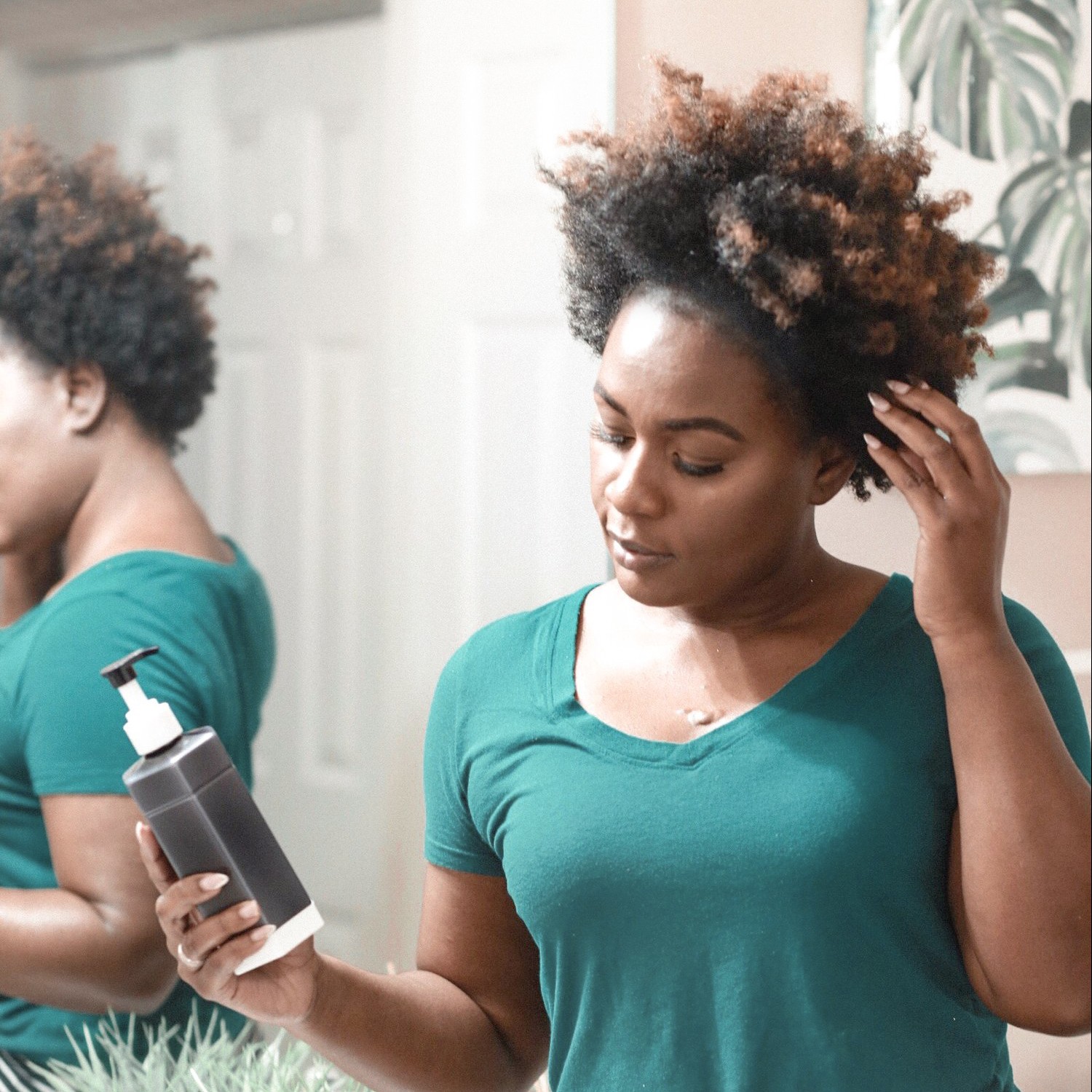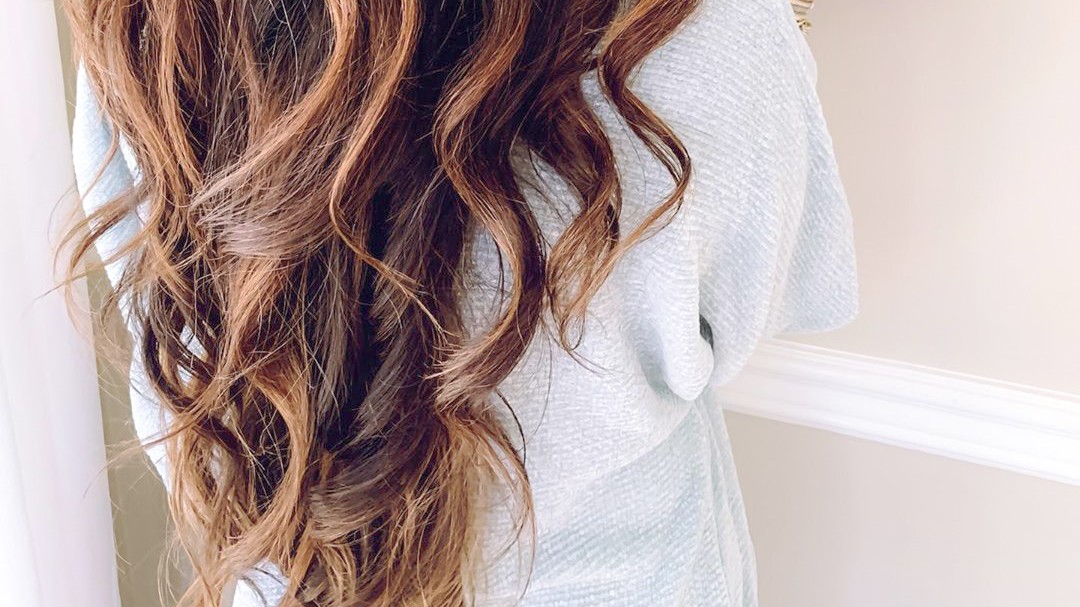Hair texture can change for a lot of different reasons, probably more than we can fit in a single blog post. That being said, here are the highlights:
Your hair is getting older
Hair isn't indestructible, and it doesn't last forever. If you've noticed that your ends are a heck of a lot thinner or duller than your roots, well, that's pretty much par for the course.
Each of your individual hair strands has what you can think of as a built-in expiration date. They're all, eventually, released by your scalp. This isn't breakage or damage -- it's totally natural, and everyone experiences it. You've probably just never noticed it before because there are always enough new hairs growing in to divert attention away from the empty follicles.
So that's one reason why hair can look differently textured at the ends -- it's lost some density. But what about reductions in shine and curl?
 Besides having a built-in expiration date, hair becomes weathered as it gets older. To illustrate -- let's say you straighten your hair a hundred times a year, and have been doing so for five years. If you look at the oldest parts of your hair (AKA your ends), they might look pretty fried -- after all, they've undergone a thousand straightenings. But if you look at a part of your hair that's close to your roots, it'll have gone through maybe only two or three hundred straightenings, and will have accumulated less damage.
Besides having a built-in expiration date, hair becomes weathered as it gets older. To illustrate -- let's say you straighten your hair a hundred times a year, and have been doing so for five years. If you look at the oldest parts of your hair (AKA your ends), they might look pretty fried -- after all, they've undergone a thousand straightenings. But if you look at a part of your hair that's close to your roots, it'll have gone through maybe only two or three hundred straightenings, and will have accumulated less damage.
Even if you don't straighten your hair two hundred times a year, your hair will still become damaged over time, be it by sunlight, water, shampoo, aggressive brushing, whatever. 'Tis destiny.
You're getting older
...And speaking of aging, here's another hard truth. Like it or not, the hair that you grow at age 60 might not look like the hair that you grew at age 20.
As we age, our hair follicles produce less sebum (your hair and skin's built-in moisturizing system), causing hair to become finer and less bouncy. BUT, this hair texture also dries more quickly after a wash and can hold some hairstyles for longer than before. If that's not a silver lining (pun intended), then we don't know what is.
Your environment changed it
Environment is huge, y'all. If you move to a place with hard water, you might find that your hair becomes more tangly and less manageable. And if you visit a humid location, you could experience a serious case of the frizzies. Fortunately, a lot of these changes go away if you leave the problematic environment -- your frizzies will almost certainly depart with the humidity, and the unmanageability of hard water will go away after a few soft-water showers.
 Other changes can't be so quickly undone. If you live in Hawaii and your hair has been damaged from years of sun and salt-water exposure, moving to Alaska won't make your damage magically go away. Instead, you'll have to invest in some serious restoration and do your best to curtail future damage.
Other changes can't be so quickly undone. If you live in Hawaii and your hair has been damaged from years of sun and salt-water exposure, moving to Alaska won't make your damage magically go away. Instead, you'll have to invest in some serious restoration and do your best to curtail future damage.
Something within your body has changed
Sometimes a change in hair texture is how your body tells you that something needs your attention. For example, people who are chronically malnourished typically grow hair that's thinner and frailer than people who are able to consume a full and healthy diet. The same goes for individuals who misuse alcohol: chronic alcohol use can lead to chronic dehydration as well as malnourishment. We also see this in individuals who use illicit substances -- stimulants such as cocaine and methamphetamine have been linked to hair loss and damage to the hair's structure.
But because hair growth is pretty slow, these changes might only be evident several weeks after the biological change has occurred -- still, we recommend getting checked out by a doctor ASAP if you think there might be an internal reason for your hair's change.
You changed it on purpose
Intentionally changing your hair texture goes way beyond perming, relaxing, et cetera. To illustrate -- if you've ever washed your hair because it felt limp and greasy, you've purposefully changed the texture of your hair. The same goes for if you've ever conditioned your hair, or gotten a blowout.
 Sure -- a lot of these activities are done for temporary effect. Every time you wash your hair, you have the expectation that it will get oily again. Every time you straighten your hair, you know that as soon as it gets wet it'll go back to its natural state. Even when you relax or otherwise permanently alter the interior structure of your hair, you still have the knowledge that more of your natural hair will keep growing out of your scalp.
Sure -- a lot of these activities are done for temporary effect. Every time you wash your hair, you have the expectation that it will get oily again. Every time you straighten your hair, you know that as soon as it gets wet it'll go back to its natural state. Even when you relax or otherwise permanently alter the interior structure of your hair, you still have the knowledge that more of your natural hair will keep growing out of your scalp.
Our point is that hair is a pretty darn flexible entity, which is totally awesome. Being able to change your hair texture whenever you darn well please to make it align with the style you want to share with the world is pretty cool, no?
Thirsty for more hair knowledge? Here's what to check out next:
How Often Should You Brush Your Hair?
We talked to the experts to find out
Living With An Oily Scalp + Dry Ends
#unfair, right?
How Long Does It Take For Hair To Grow Back?
How long does it take for hair to grow back after a bad cut?
Is Hair Alive?
The answer might be a little more complicated than you thought 👀


 Besides having a built-in expiration date, hair becomes weathered as it gets older. To illustrate -- let's say you straighten your hair a hundred times a year, and have been doing so for five years. If you look at the oldest parts of your hair (AKA your ends), they might look pretty fried -- after all, they've undergone a thousand straightenings. But if you look at a part of your hair that's close to your roots, it'll have gone through maybe only two or three hundred straightenings, and will have accumulated less damage.
Besides having a built-in expiration date, hair becomes weathered as it gets older. To illustrate -- let's say you straighten your hair a hundred times a year, and have been doing so for five years. If you look at the oldest parts of your hair (AKA your ends), they might look pretty fried -- after all, they've undergone a thousand straightenings. But if you look at a part of your hair that's close to your roots, it'll have gone through maybe only two or three hundred straightenings, and will have accumulated less damage.  Other changes can't be so quickly undone. If you live in Hawaii and your hair has been damaged from years of sun and salt-water exposure, moving to Alaska won't make your damage magically go away. Instead, you'll have to invest in some serious restoration and do your best to curtail future damage.
Other changes can't be so quickly undone. If you live in Hawaii and your hair has been damaged from years of sun and salt-water exposure, moving to Alaska won't make your damage magically go away. Instead, you'll have to invest in some serious restoration and do your best to curtail future damage.